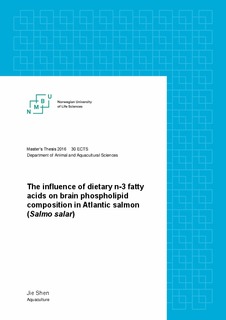The influence of dietary n-3 fatty acids on brain phospholipid composition in Atlantic salmon (Salmo salar)
Master thesis

View/
Date
2016-08-18Metadata
Show full item recordCollections
- Master's theses (IHA) [318]
Abstract
A feeding experiment was conducted to examine the percentages of different fatty acids in brain phospholipid subclasses under feeding dietary inclusion levels of EPA, DHA or a 1:1 mixture of EPA and DHA in farmed Atlantic salmon. The aim was to investigate how EPA alone, DHA alone or a mix of different doses influence the fatty acids in phospholipid subclasses, and how EPA and DHA deficiency influence the brain phospholipids. Fourteen dietary groups of Atlantic salmon, were fed diets with increasing inclusion levels of EPA, DHA or a 1:1 mixture of EPA and DHA, defined as 0, 0.5, 1, 1.5 or 2% of the feed dry weight, and a commercial diet. The 0 (negative control; NC), 2% and commercial dietary (commercial control; CC) groups were in triplicate, while the dietary groups containing 0.5, 1 and 1.5% were in duplicate tanks. This experiment started at the average fish body weight of 40g, and the brain was taken from 5 fish from each tank in each dietary group when the average fish body weight reached 200g (after 131 d) and 400g (after 186d). These samples were treated by lipid extraction, double TLC and GC to separate the different phospholipid subclasses and determine the fatty acid composition of each subclass.
In salmon brain, PC had higher 16:0 and 18:1n-9 and the lowest percentage of Ʃ n-3 fatty acids, PI was characterized by higher 18:0 and 20:4n-6, and PS and PE contained the highest percentages of 22:6n-3. Through PCA, only NC group is separated from the rest of the dietary groups, while there were no clear groupings of the other dietary groups. Furthermore, four phospholipid classes showed increased 20:5n-3 and 22:6n-3 incorporation and concomitantly decreased levels of Ʃ n-6 and Ʃ n-9 fatty acids, with increasing dietary levels of EPA, DHA or a mix of EPA and DHA. For the most of fatty acids, there was only a significant difference in the NC group. When the fish was fed a diet without EPA and DHA, the brain remained containing quite high amounts of EPA and DHA, and DHA was more retained than EPA.
In conclusion, phospholipids were characterized by a high degree of percentages of n-3 PUFA (20:5 and 22:6) and low percentages of n-6 PUFA, however, each phospholipid subclass had different characteristic fatty acids. The brain phospholipid fatty acid composition was conserved to a high degree and little affected by the diet.